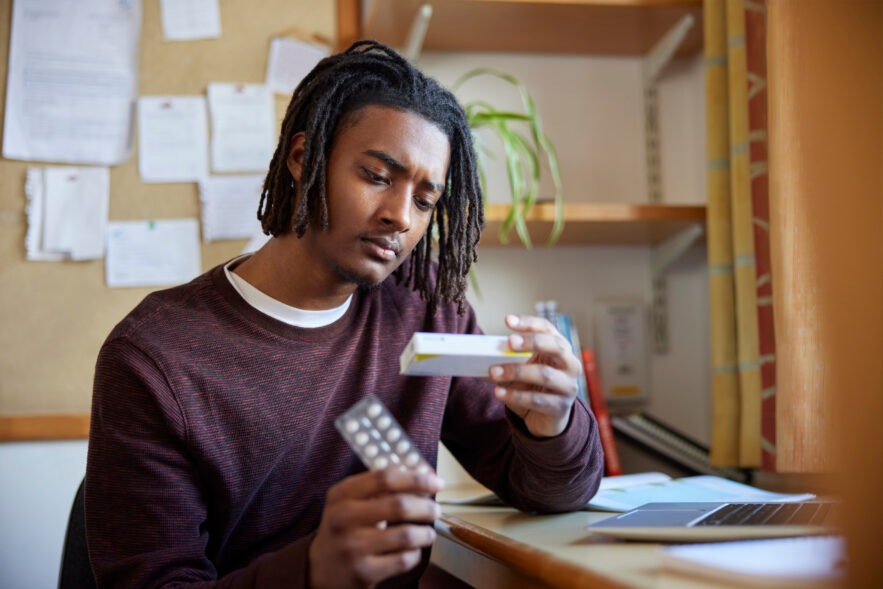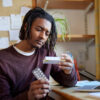K. Arnold, who asked that we only use his first initial to maintain his medical privacy, first heard about doxy-PEP, a medication that can help prevent sexually transmitted infections (STIs) if taken shortly after unprotected sex, from an Instagram ad. He has always taken good care of his health, and as a man who has sex with men, he knows he has an elevated risk of contracting an STI. But he started taking extra care after he learned a previous partner had not been faithful.
On the rare occasion that he has had sex without a condom over the past year, he quickly found an online healthcare platform where he could get a prescription for doxy-PEP. He hasn’t experienced many side effects from doxy-PEP after having taken it about three times, but he has endured the stress of not having his prescription filled on time, and wondering if he was still protected. If you’re considering doxy-PEP, here’s what you need to know.
What Is Doxy-PEP Used For?
The “PEP” in doxy-PEP stands for post-exposure prophylaxis. The drug is a single dose of an antibiotic that you take as soon as possible (up to 72 hours) after having sex without a condom. It helps prevent sexually transmitted infections (STIs) caused by bacteria including syphilis, chlamydia, and gonorrhea from taking hold in your body. It does not prevent viral infections such as human immunodeficiency virus (HIV).
Is Doxy-PEP Safe?
There were not very many side effects observed during the clinical trials for doxy-PEP. The most common side effect of doxy-PEP was diarrhea or gastrointestinal symptoms, which is commonly reported with all types of antibiotics. One patient (out of over 300 who took the medication) in one of the clinical trials had elevated liver enzymes on a blood test, signifying his liver was stressed or damaged, and another single individual reported headaches.
The risk of esophageal ulcers or other gastrointestinal symptoms such as nausea is higher if you lay down within an hour of taking the medication or take it on an empty stomach. Arnold says he was instructed not to lay down for about 30 minutes after taking the medication.
Arnold said his stomach was a little upset the first time he took doxy-PEP, but it was “nothing so extreme where it’s extremely painful. I had to take antibiotics before, and I do specifically recall having diarrhea and other things like that, but not while taking these.”
The drug can also enhance the effects of blood thinners. If you take both doxycycline and blood thinners at the same time, you may need to reduce your dose of the blood thinner to prevent bleeding.
How Long Does It Take Doxy-PEP to Work?
You have to take doxy-PEP within 72 hours of having had unprotected sex for it to be effective, and ideally within 24 hours if possible. However, Arnold points out that that isn’t always possible. He received three prescriptions for doxy-PEP over the last year through an online prescriber, but only once was his pharmacy able to fill the prescription within that 72-hour window. He was anxious at the time, but, “I still went and got tested [for STIs], and I had my results by the time the Doxy-PEP was available,” he says.
How Effective Is Doxy-PEP?
Two clinical trials tested doxy-PEP in men who have sex with men. The first, conducted in France and published in 2017, showed that taking the drug after unprotected sex cut the risk of contracting an STI in half. The drug was not effective against gonorrhea but did seem to prevent syphilis and chlamydia. The second study, which took place in San Francisco and Seattle, tested the drug in men who had sex with men and transgender women (assigned male at birth), and was published in 2023. Again, the drug was most effective in preventing syphilis and chlamydia, and less effective at preventing gonorrhea. Taking doxy-PEP lowered the risk of getting a bacterial STI by two-thirds. One of the strengths of the second study is that it included participants who were HIV positive and those who were already using PrEP to prevent HIV.
Who Should Take Doxy-PEP?
So far, the drug has only been tested in men who have sex with men and transgender women (assigned male at birth). The study populations have included individuals who are HIV positive as well as HIV negative and who are simultaneously using PrEP to prevent HIV. Doxy-PEP has, so far, demonstrated inconsistent results in women and those assigned female at birth. A 2023 study suggested that the drug was ineffective in those assigned female at birth, though experts emphasized that many of those in the trial didn’t take the drug as directed. Additionally, pregnant women should avoid doxycycline, because it can hinder bone growth in the fetus.
What Foods Should You Avoid While Taking Doxycycline?
Drinking lots of water can make it easier to swallow and taking it with a meal can help lower your risk of nausea or other gastrointestinal side effects of Doxy-PEP. Experts also suggest avoiding dairy products, calcium, multivitamins, or antacids for two hours before and after taking the drug, because calcium can lower the amount of doxycycline you absorb.
Side Effects of Longer-Term Use of Doxycycline
Doxycycline, the antibiotic in doxy-PEP, is used to treat many other conditions and even prevent some other infections such as malaria. For these purposes, you’d need to take doxy-PEP for weeks to months. In these cases, patients have reported more intense side effects such as:
- Increased photosensitivity (rashes or sunburns upon exposure to sunlight)
- Pancreatitis
- Esophageal ulcers
- Skin irritation
- Intracranial hypertension, a dangerous buildup of pressure around the brain that can cause headaches and blurry vision.
- Birth defects if taken during pregnancy
Should You Be Concerned About Antibiotic Resistance with Doxy-PEP?
So far, there have been signals that brief exposures to doxy-PEP might raise the risk of antibiotic-resistant microbes emerging, but experts also note that doxycycline is already used in a similar fashion to prevent Lyme disease after a tick bite.
Arnold says he’s keeping up with research on the drug.
“I saw an article about a group that it was tested on and the concerns about bacteria potentially forming resistance to the drug,” he says. He’d also love to see if it can be made even more effective. The existing risk reduction “is better than zero additional preventative care for sure. But it would be awesome to see more research going into this.”






